18.3: Phylum Rhodophyta - The Red Algae
- Page ID
- 29592
The red algae represent a monophyletic group of organisms. Members of this group share the following characteristics:
- Morphology: Unicellular to multicellular, no flagellated stages. Cells of multicellular species are connected via incomplete cytokinesis, resulting in pit connections.
- Cell wall composition: Cellulose and galactans
- Chloroplasts: 2 membranes, pigments are chlorophyll a and phycobilins (primarily phycoerythrin, providing their red color)
- Storage carbohydrate: Floridean starch
- Life cycle: Alternation of generations with an extra diploid stage, the carposporophyte
- Ecology: Primarily marine (97% of species)
Selection Pressures and Drivers
An important aspect of understanding the life history traits of the Rhodophyta is understanding the challenges of living in a marine environment.
- Access to sunlight: Most colors of light cannot penetrate into deeper water, as they are scattered by water molecules. The wavelengths of light that reach deepest into the ocean are blue and green. Many fish that live in the deep ocean are red. Because red light does not penetrate to the depths where they live, this makes them virtually undetectable by sight. Remember, we see things because of the light that bounces off of them. Red pigments reflect red light, so no red light, no reflected light. Red algae are using a similar strategy--absorb the wavelengths of light that are not red--with a different goal: to use that absorbed light to make food. The phycoerythrin in their chloroplasts reflects red light, giving them a red appearance, and absorbs the blue light that is able to penetrate to deeper areas in the water column.
- Fertilization: The ocean is an expansive environment, often with large areas of open space between populations of organisms. In this environment, successful fertilization of an egg by a nonmotile sperm--red algae lack flagella--presents a challenge. Having multicellular haploid and diploid phases provides red algae more opportunities to produce gametes and spores. A diploid stage that clones the zygote, the carposporophyte, provides more opportunities to do meiosis from each fertilization event.
- Salinity: Marine environments are relatively high in salinity. A possible adaptation for this is to have sulfated polysaccharides in the cell wall, such as the galactans present in Rhodophyta. This is a strategy present in (potentially all) marine algae and is inferred to be an adaptation for salinity-tolerance. See this open-access article for further information: https://doi.org/10.1371/journal.pone.0018862
Observing the Red Algal Life Cycle
Polysiphonia is the model organism for Rhodophyta. Red algae have an alternation of generations life cycle that has an extra diploid stage: the carposporophyte. The gametophytes of Polysiphonia are isomorphic (iso- meaning same, morph- meaning form), meaning they have the same basic morphology. Use prepared slides and the images in the following pages to label the life cycle diagram below.
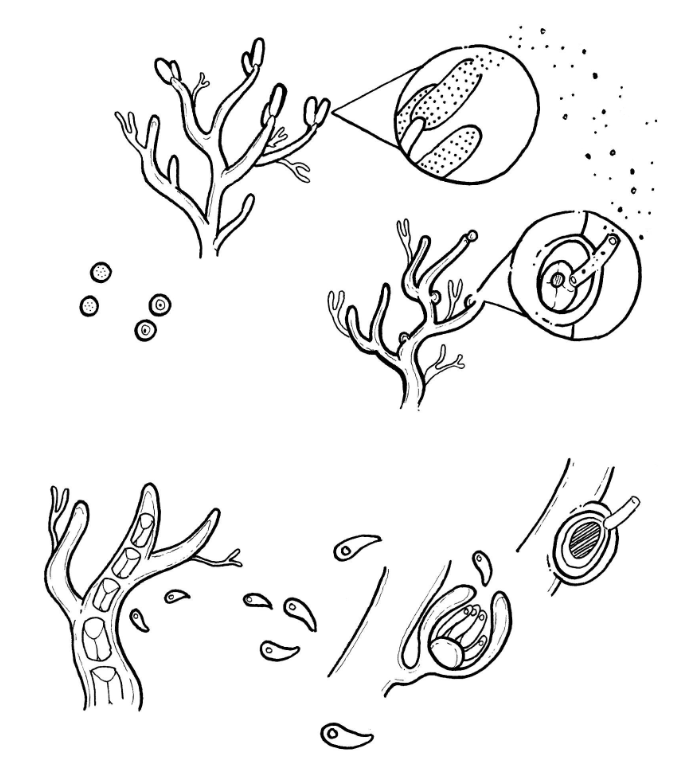
In the diagram above, indicate where meiosis and fertilization occur. Color the haploid and diploid tissue differently, and draw arrows to show when mitosis is happening.
Observe a prepared slide of a Polysiphonia male gametophyte. The male gametophyte (shown on right) has elongated structures that emerge from the tips of the thallus branches. These are spermatangia, where spermatia are produced by mitosis. Label the bolded features in the life cycle diagram.
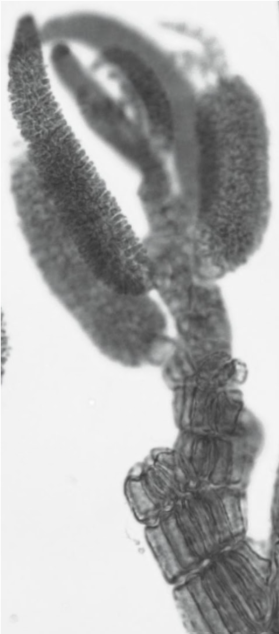
Female gametophyte stages shown below:
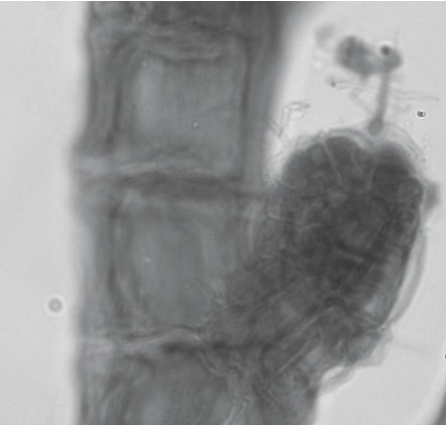
Observe a prepared slide of a Polysiphonia female gametophyte. The female gametophyte produces an egg that is contained within a structure called the carpogonium. This structure has a long, thin projection called a trichogyne (trich- meaning hair, -gyne meaning female). During fertilization, a spermatium fuses with the trichogyne and the nucleus of the spermatium travels down the tube to the egg. When the nucleus of the spermatium fuses with the egg, a zygote is produced. This zygote is retained and nourished by the female gametophyte as it grows.
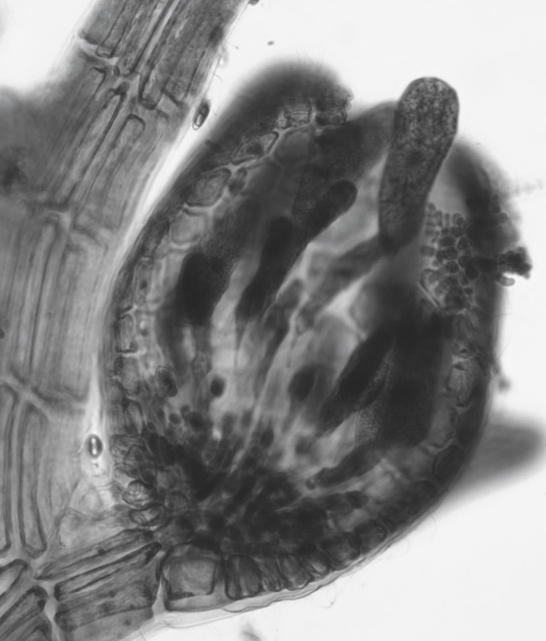
The globose structures you see growing from the female gametophyte thallus are called cystocarps. A cystocarp is composed of both female gametophyte tissue (n) and carposporophyte tissue (2n). The outer layer of the cystocarp, the pericarp (peri- meaning around) is derived from the female gametophyte and is haploid.
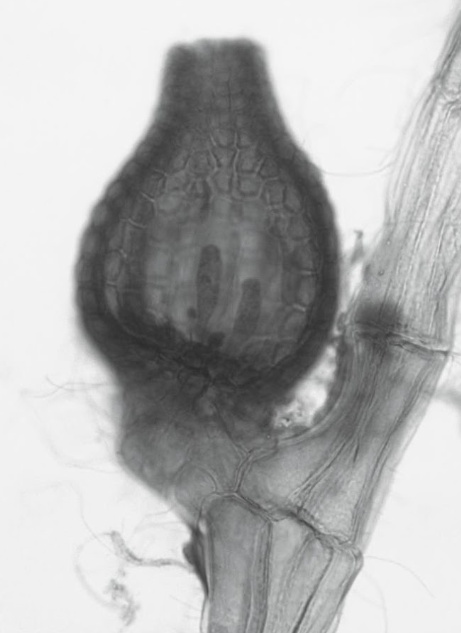
The interior of the cystocarp consists of the carposporophyte, which is diploid, and produces elongated structures called carposporangia, inside of which it produces carpospores by mitosis. All of these--carposporophyte, carposporangia, and carpospores--are diploid. Label the bolded features in the life cycle diagram and color them according to their ploidy.
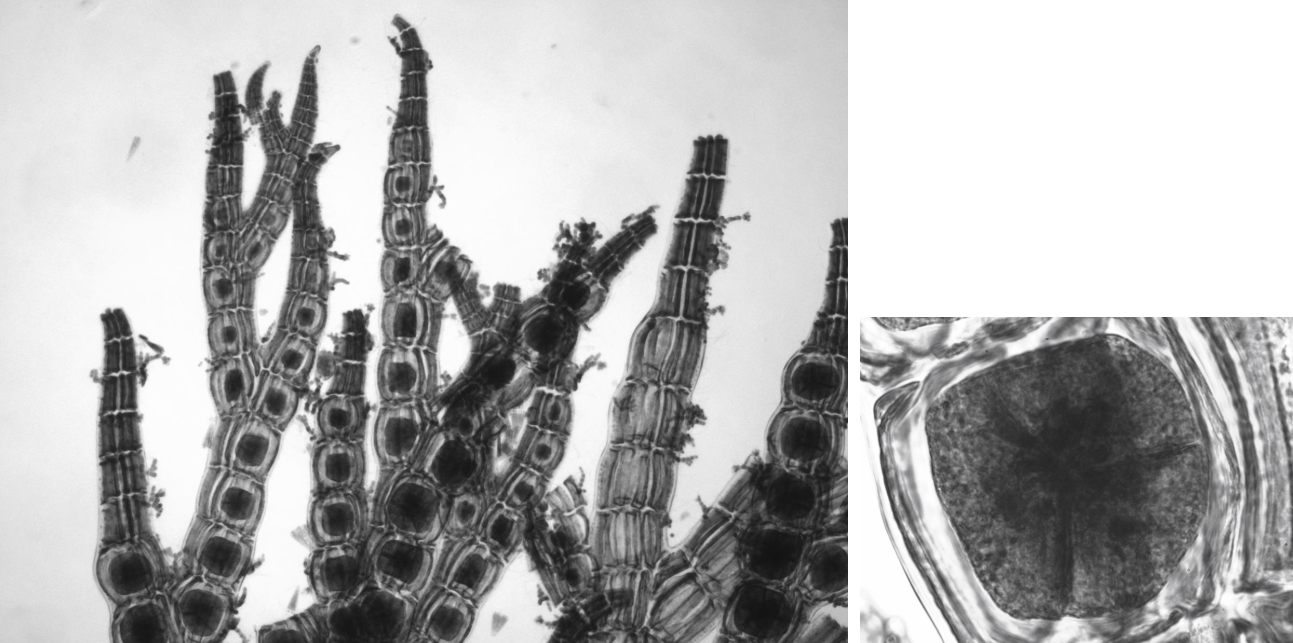
Observe a prepared slide of a Polysiphonia tetrasporophyte. The diploid carpospores are released into the ocean waters, where they will be carried on currents to another location. If the carpospore lands in an appropriate environment, it will grow by mitosis into a tetrasporophyte (2n). The tetrasporophyte produces tetrasporangia (2n) within the branches of the thallus. Each tetrasporangium produces four unique, haploid tetraspores by meiosis.
Tetraspores (n) are released and will grow by mitosis into either male or female gametophytes, completing the life cycle. Label the bolded features in the life cycle diagram.


